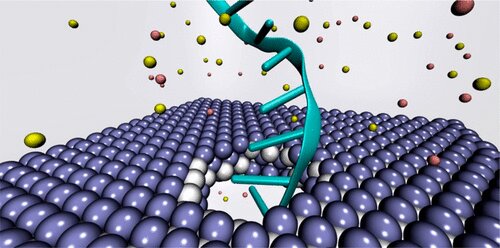[ad_1]
The superior mechanical ability as well as the thermal and chemical stability of MXene make it a strong option for solid-state DNA sequencing with nanopores. Credit: Mechanical and AI Lab, College of Engineering, Carnegie Mellon University
It took 13 years and a billion dollars to decipher the human genome, an enormous scientific endeavor that ushered in a new era in medicine. With today’s advances in sequencing technology, the same task would have taken about a day at a fraction of the cost. Tomorrow’s technology could reduce this to seconds.
Nanopore-based DNA sequencing is a third generation technology that has the potential to further transform healthcare by providing rapid disease diagnosis and personalizing medicine. The more efficient the method, the better. As companies begin to commercialize the technology, there are still some hurdles to overcome.
A currently used nanopore method is protein-based, i.e. biological. It uses membrane protein complexes that have the ability to differentiate between individual and groups of nucleotides. Unfortunately, the proteins disintegrate during the intensive use that is required for sequencing – which can happen a million times over with the nanopore membrane.
In contrast, synthetic materials are used in solid-state nanopore sequencing. Two-dimensional nanomaterials such as graphene, silicon nitride and molybdenum disulfide offer superior mechanical capabilities as well as thermal and chemical stability. But there are still disadvantages to this method. Scientists need further research to better understand and characterize these various solid-state materials.
Carnegie Mellon University researchers were intrigued by recent developments in the synthesis of another nanomaterial, MXene. Also known as titanium carbide, it belongs to a class of single-layer, two-dimensional inorganic compounds that are several atoms thick. Nobody had previously used this material for use in nanopore DNA sequencing. The results were published in the journal ACS Nano.
MXene are characterized by their properties that combine aspects of metals and ceramics, including excellent thermal and electrical conductivity, heat resistance, easy machinability and excellent volumetric capacity.
The researchers wanted to explore MXene as a potential membrane material for DNA detection and observe how it intersects with other nanomaterials. To study this, they used molecular dynamics simulations to analyze their interactions with single-stranded DNA. They measured physical properties such as ion current, residence time, traces of DNA bases, physisorption, flexibility of the bases and hydration of the nanopore.
A nanopore array can contain hundreds of pores with diameters smaller than eight nanometers. “If the nanopores are too large, all of the genetic material comes through the membrane mixed together,” explains Amir Barati Farimani, assistant professor of mechanical engineering. “If it’s too small, it can’t get through at all.”
The team found that an MXene-based nanopore could detect different types of DNA bases with high sensitivity. “We have shown that MXene is an effective and promising nanomaterial for use in a nanopore-based detection platform,” said Barati Farimani.
The researchers want to expand their work by using powerful artificial intelligence (AI) algorithms to improve DNA detection by the nanopore system. DNA bases have unique properties that can be used as input to train the AI ​​to improve the accuracy of DNA detection. And the AI ​​can use high-dimensional simulation data to learn and extract the key features used to distinguish the DNA bases.
“The extensions to this work promise a huge improvement in the nanopore-based detection platform and ultimately, overcoming the threshold to make this technology widely applicable,” said Barati Farimani.
Other authors were Prakarsh Yadav and Zhonglin Cao, both Ph.D. Students.
Research advances emerging DNA sequencing technology
Prakarsh Yadav et al., DNA detection with single-layer Ti3C2 MXene nanopore, ACS Nano (2021). DOI: 10.1021 / acsnano.0c09595
The work was supported by Carnegie Mellon’s Center for Machine Learning in Health (CMLH) and the Department of Mechanical Engineering. Computing resources were provided by the Pittsburgh Supercomputing Center (PSC). Barati Farimani heads the Mechanical and AI Lab at the College of Engineering.
Provided by Carnegie Mellon University Mechanical Engineering
Quote: Pushing through nanopores: Genetic sequencing with MXene (2021, June 25), accessed June 25, 2021 from https://phys.org/news/2021-06-nanopores-genetic-sequencing-mxene.html
This document is subject to copyright. Except for fair trade for private study or research purposes, no part may be reproduced without written permission. The content is provided for informational purposes only.
[ad_2]

